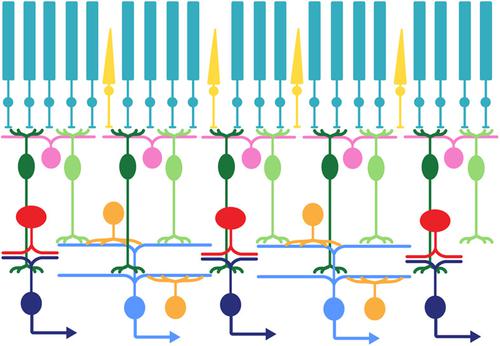当前位置:
X-MOL 学术
›
WIREs Mech. Dis.
›
论文详情
Our official English website, www.x-mol.net, welcomes your
feedback! (Note: you will need to create a separate account there.)
Molecular mechanisms regulating synaptic specificity and retinal circuit formation.
WIREs Mechanisms of Disease ( IF 4.6 ) Pub Date : 2020-04-08 , DOI: 10.1002/wdev.379 Hannah K Graham 1, 2 , Xin Duan 1, 2, 3, 4
WIREs Mechanisms of Disease ( IF 4.6 ) Pub Date : 2020-04-08 , DOI: 10.1002/wdev.379 Hannah K Graham 1, 2 , Xin Duan 1, 2, 3, 4
Affiliation

|
The central nervous system (CNS) is composed of precisely assembled circuits which support a variety of physiological functions and behaviors. These circuits include multiple subtypes of neurons with unique morphologies, electrical properties, and molecular identities. How these component parts are precisely wired‐up has been a topic of great interest to the field of developmental neurobiology and has implications for our understanding of the etiology of many neurological disorders and mental illnesses. To date, many molecules involved in synaptic choice and specificity have been identified, including members of several families of cell‐adhesion molecules (CAMs), which are cell‐surface molecules that mediate cell‐cell contacts and subsequent intracellular signaling. One favored hypothesis is that unique expression patterns of CAMs define specific neuronal subtype populations and determine compatible pre‐ and postsynaptic neuronal partners based on the expression of these unique CAMs. The mouse retina has served as a beautiful model for investigations into mammalian CAM interactions due to its well‐defined neuronal subtypes and distinct circuits. Moreover, the retina is readily amenable to visualization of circuit organization and electrophysiological measurement of circuit function. The advent of recent genetic, genomic, and imaging technologies has opened the field up to large‐scale, unbiased approaches for identification of new molecular determinants of synaptic specificity. Thus, building on the foundation of work reviewed here, we can expect rapid expansion of the field, harnessing the mouse retina as a model to understand the molecular basis for synaptic specificity and functional circuit assembly.
中文翻译:

调节突触特异性和视网膜回路形成的分子机制。
中枢神经系统 (CNS) 由精确组装的电路组成,支持各种生理功能和行为。这些电路包括具有独特形态、电特性和分子特性的多种神经元亚型。这些组成部分如何精确连接一直是发育神经生物学领域非常感兴趣的话题,并且对我们理解许多神经障碍和精神疾病的病因具有重要意义。迄今为止,已经鉴定了许多涉及突触选择和特异性的分子,包括几个细胞粘附分子 (CAM) 家族的成员,这些分子是介导细胞间接触和随后的细胞内信号传导的细胞表面分子。一个受欢迎的假设是 CAM 的独特表达模式定义了特定的神经元亚型群,并根据这些独特 CAM 的表达确定了兼容的突触前和突触后神经元伙伴。由于其明确的神经元亚型和独特的回路,小鼠视网膜已成为研究哺乳动物 CAM 相互作用的美丽模型。此外,视网膜很容易进行电路组织的可视化和电路功能的电生理测量。最近遗传、基因组和成像技术的出现为识别突触特异性的新分子决定因素的大规模、无偏见的方法开辟了道路。因此,在此处回顾的工作基础上,我们可以期待该领域的快速扩展,
更新日期:2020-04-08
中文翻译:

调节突触特异性和视网膜回路形成的分子机制。
中枢神经系统 (CNS) 由精确组装的电路组成,支持各种生理功能和行为。这些电路包括具有独特形态、电特性和分子特性的多种神经元亚型。这些组成部分如何精确连接一直是发育神经生物学领域非常感兴趣的话题,并且对我们理解许多神经障碍和精神疾病的病因具有重要意义。迄今为止,已经鉴定了许多涉及突触选择和特异性的分子,包括几个细胞粘附分子 (CAM) 家族的成员,这些分子是介导细胞间接触和随后的细胞内信号传导的细胞表面分子。一个受欢迎的假设是 CAM 的独特表达模式定义了特定的神经元亚型群,并根据这些独特 CAM 的表达确定了兼容的突触前和突触后神经元伙伴。由于其明确的神经元亚型和独特的回路,小鼠视网膜已成为研究哺乳动物 CAM 相互作用的美丽模型。此外,视网膜很容易进行电路组织的可视化和电路功能的电生理测量。最近遗传、基因组和成像技术的出现为识别突触特异性的新分子决定因素的大规模、无偏见的方法开辟了道路。因此,在此处回顾的工作基础上,我们可以期待该领域的快速扩展,











































 京公网安备 11010802027423号
京公网安备 11010802027423号